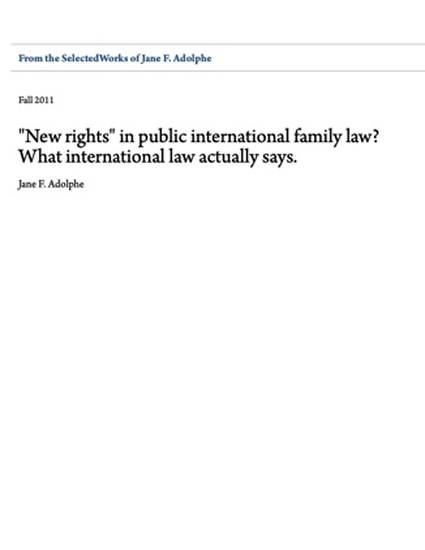
Article
"New rights" in public international family law? What international law actually says.
Ave Maria Law Review
(2011)
Abstract
Recent debates within the United Nations system have involved issues relating to the controversial topic of "new human rights," an expression which carries a hidden meaning generally attempting to exclude discussions about the ethical, moral, and natural law considerations concerning abortion, human sexuality, marriage, and the family. The terms "sexual orientation" and "gender identity," and their implicit "new human rights" (e.g.,same-sex marriage) have been the subject matter of much debate. The two concepts "sexual orientation" and "gender identity" are, by their very nature, interior and subjective self-determinations, subject to revision like any other desire or inclination. Most countries recognize the difference between feelings, desires, or inclinations, on the one hand, and behaviours or actions, on the other hand. In particular, the Holy See, a sovereign subject of international law, and Permanent Observer to the United Nations contends that: "[A] state should never punish a person, or deprive a person of the enjoyment of any human right, based just on the person's feelings and thoughts, including sexual thoughts and feelings. But states can, and must, regulate behaviours, including various sexual behaviours." The Holy See has a sacred and legal duty to protect children, and given the actions, including crimes of sexual abuse of children, by some clergy, religious, and laity, the Holy See among other things, reminds the world that "there is a consensus between societies that certain kinds of sexual behaviours must be forbidden by law. Paedophilia and incest are two examples."
Nonetheless, in the face of growing concerns about the sexual exploitation and sexualisation of children, some lobbying groups are vigorously working to sanitize paedophilia. These initiatives refer to the disorder of paedophilia as II adult-child" or II adult-minor" sex. They challenge the assumption that sex between adults and children is always damaging to thechild, and/or defend man-boy sexual contacts and adult-juvenile sex in general. They find support from thousands of websites presently promoting the acceptance and normalization of child sexual abuse, for example, from political parties founded on the platform of legalizing child-adult sexual activity, and academic gatherings convened to challenge the current diagnosis of paedophilia as a mental disorder. Consequently, one might well query whether, in the near future, paedophilia might be regarded as a "sexual orientation."
In an effort to make their case internationally, those who promote "new human rights" rely upon non-binding documents (e.g., General Comments of United Nations Treaty Bodies, Reports of United Nations Special Rapporteurs, decisions of regional and national courts, and even principles drafted by individuals). The reason for this approach is obvious. There are no binding treaties, which acknowledge such rights.
The purpose of this Article is to review the written texts of important international human rights documents in the area of public international family law, including the rights of the family, parents, and children. This Article fleshes out the legal-anthropological "golden thread" that runs through international human rights law within the system of the United Nations. It provides a "good faith" interpretation in light of the "ordinary meaning" of the words in the written text taking into consideration a certain common-sense understanding of humanity and society. More descriptive than analytical in nature, this Article will consider what is contained in the International Bill of Human Rights and the Convention on the Rights of the Child ("CRC"). The Article contends that the 1948 Universal Declaration of Human Rights ("UDHR"), the foundational text for the modem human rights movement, and the two 1966 Covenants-the International Covenant on Civil and Political Rights("ICCPR") and the International Covenant on Economic, Social and Cultural Rights ("ICESCR") (together, the "International Bill of Human Rights")- remain the linchpin for understanding documents such as the 1989 Convention on the Rights of the Child.This Article argues that these documents, when considered as an integral whole, reveal an interconnectedness between the nature and meaning of the human person, his or her human dignity, as well as the rights of the family, parents, and children. It is beyond the scope of this Article to consider the drafting history of key documents and their working papers, such as the UDHR, since such an appeal to supplementary sources of interpretation is unnecessary for the purposes of this Article and has been studied elsewhere.
The Article is divided into six parts. Part I discusses the human person and his or her dignity. Part II studies the special protection given the family, based on marriage. Part III explores the rights and duties of parents. Part IV considers the rights and duties of the child as they relate to the family and parents. Part V responds to certain objections to the interpretation provided herein; given the brevity of this Article, it does not seek to raise and address every possible counterargument. Part VI discusses implications for lawmaking.
Disciplines
Publication Date
Fall 2011
Citation Information
Adolphe, Jane. "'New Rights' in Public International Family Law? What International Law Actually Says." Ave Maria Law Review 10, no. 1 (Fall 2011): 149-170, available at https://works.bepress.com/ProfessorJaneAdolphe/39/
